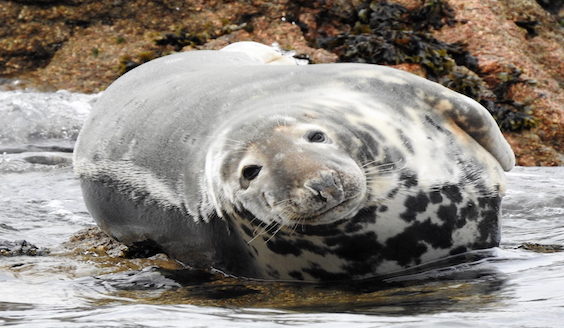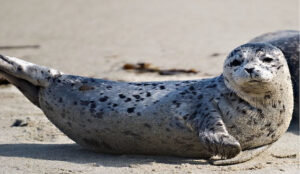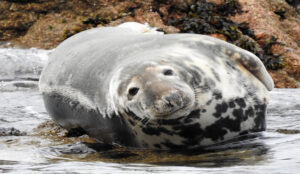Seals
Click on a picture below to jump directly to that Seals information
Common or Harbour Seal

Although Common Seals are seen in groups of more than 100 basking contentedly in the sun, they are not really social animals. Unlike Grey Seals, they do not live in organised herds, no are they noisy, even at breeding time. Common Seals are placid and tend to be found on sand-banks around sheltered shores such as estuaries and sea-lochs. Common Seals mate at sea in early Autumn. A Female (cow) has only one pup a year, usually born June or July on an exposed rock or sand-bank. The pup can swim almost from birth and may go to sea on the next tide. Pups suckle on land or in the water for a month or more. The fore limb is a flipper with with five long black claws normally held close to the body. It acts as a stabiliser in the water. Common Seals will, however, haul themselves onto sea-weed covered-rocks close to deep water to bask, often returning to the same place day after day and departing to feed only when the incoming tide displaces them. On sand-banks they allow the outgoing tide to strand them on the highest point, a good lookout position where they may stay for several hours, and when basking the body is arched with the tail flippers and small rounded head are raised. Common Seals vary in colour but are mottled with dark spots, from a distance they look pale when they are dry. The male is 68 inches (173 cm) long. Female is smaller. In the water the Common seals rounded head looks like a buoy or a fishing float its short muzzle and ‘V’ shaped nostrils help to distinguish it from the Grey Seal, that has nostrils that are almost parallel. If disturbed they move closer to the water’s edge, ready for a quick get-away. Fish are the main food caught mostly by diving to search the sea bed. Flatfish and other bottom dwelling fish are taken. Young Common Seals may eat shrimps. They have good eyesight on land or under water, and unless they are asleep it is not easy to approach them on open sandbanks. About 6,000 Common Seals, about one third of the British population, live around The Wash but they travel considerable distances along the East coast, probably following fish shoals. Common Seals are protected by law during the breeding season (June 1st to August 31st). They mat live for 20 to 30 years. Common Seals are found along the East Coast of Britain from the Thames Estuary Northwards to Scotland, the Outer Hebrides, the West Coast of Scotland and all the islands in the Inner Hebrides, and in the Orkneys and Shetland Isles. It is found around all the coasts of Ireland. It is absent from Cumbria, Wales, Southwest England and along the whole of the South Coast to Kent, but can appear as a rare straggler where it has occurred in the St. Ives Bay on Occasions.
Atlantic Grey seal

Grey or (Atlantic Seals), may be seen off most of Britain’s coasts but are most numerous around Scotland particularly the offshore islands, and southwest Britain. They gather to breed on shore, sometimes in their hundreds, from September to December and are legally protected in the United Kingdom during these months. Outside the breeding season the seal spends much of their time at sea, sometimes for weeks on end, but haul themselves onto rocks or the shore to bask from time to time. While moulting, about March, the Grey seal rest for long periods on rocks above high tide level. Their bright coats show up newly moulted seals. Cow seals are paler than bulls, especially when their fur is dry, and not nearly as heavy –only about half the weight of the bull. They are also shorter in the muzzle and thinner in the neck. In fine weather the Grey Seals haul themselves onto rocks to bask, sometimes in large numbers. Flat-headed Grey Seals may be seen sharing a rock with smaller round-headed Common Seals. Where breeding seals overflow the beach onto soil, mud patches may be formed and seals wallow in them. Wallows soon become contaminated and a risk to the seals health. The top of the Grey seals head is flat. Grey seals are often very noisy, barking, hooting, moaning, hissing and snarling, on land and in water. Grey seals eat larger fish than Common Seals. Their diet includes Cod, Whiting, and Salmon, and they will raid fishing nets to take them. Fish are the Grey Seals main food, adults eating a daily average of about 22lbs (10 kgs), although they do not feed every day. In the last 50 years the seal numbers have steadily increased. Colonies on places like the Farne Islands have become very overcrowded, causing damage to the soil and a lot of disease among the pups. Because of their large numbers and the fish consumption, and also because they carry parasites that are transmitted to fish, there have been attempts to regular licenced culling (selective killing). These aroused so much public hostility that Grey Seals are now mostly left alone. When dry, a male Grey Seals fur is a dark, blotched grey or brownish-grey. When wet it looks almost black. The head is long and pointed with a large Roman Nose, and the body very portly, with thick rolls of flesh folding around the neck. The male (bull) is about 7 feet (2.1 metres) long, female (cow) is about 6 feet long (1.8 metres)

